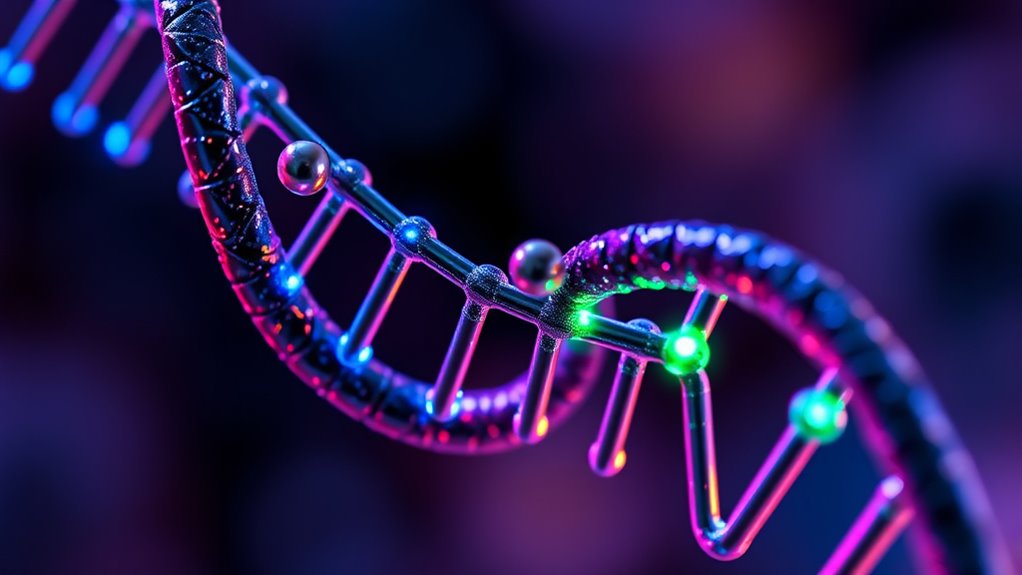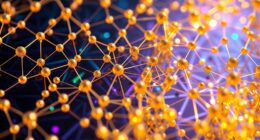Molecular nanobots are tiny machines that can navigate your bloodstream to precisely identify damaged DNA. They target specific errors or mutations and deliver repair enzymes directly to the faulty sites, supporting your body’s natural repair processes. These nanobots reduce risks and improve accuracy compared to traditional treatments, enabling personalized and less invasive therapies. By actively maintaining your genetic health, they offer a future where genetic errors can be prevented before causing disease—discover how this technology works in more detail.
Key Takeaways
- Nanobots detect specific DNA damage and precisely deliver repair enzymes to faulty genetic sites.
- They support natural repair pathways by acting as targeted, molecular repair crews within cells.
- Integrated with diagnostics, nanobots enable real-time detection and correction of genetic errors.
- Their targeted approach reduces side effects and minimizes damage to healthy DNA during repair.
- Future developments aim for proactive DNA maintenance, preventing genetic errors before disease occurs.

Advancements in nanotechnology are opening new frontiers in medicine, particularly in repairing damaged DNA. Imagine tiny nanobots, no larger than a few nanometers, steering your bloodstream to pinpoint and fix genetic errors directly at their source. These molecular machines are designed with remarkable precision, allowing you to target specific DNA sequences with incredible accuracy. This process, known as nanobot targeting, means you can direct these microscopic devices to seek out mutations, breaks, or errors within your DNA strands. Once located, the nanobots utilize sophisticated mechanisms to initiate DNA repair mechanisms, effectively restoring the genetic code to its original, healthy state. As these nanobots become more integrated with medical diagnostics, their ability to identify and respond to genetic issues will become even more refined. You won’t need invasive procedures or broad-spectrum treatments—these nanobots operate with pinpoint accuracy, reducing side effects and increasing the effectiveness of therapy. They are programmed to recognize damaged sections of DNA, whether caused by environmental factors, aging, or genetic predispositions. By honing in on these problematic areas, nanobots can deliver repair enzymes or other therapeutic agents directly where they’re needed most. This targeted approach not only speeds up the repair process but also minimizes collateral damage to healthy cells and tissues.
As you consider the potential of these tiny tools, it’s clear that their ability to manipulate DNA repair mechanisms could revolutionize medicine. Traditional treatments often rely on systemic drugs or gene editing techniques that can be imprecise or risky. With nanobots, you gain a level of control that was previously unimaginable, allowing you to enhance natural repair pathways or even introduce new, engineered solutions. These nanobots can be programmed to activate specific DNA repair mechanisms, such as base excision repair or homologous recombination, depending on the type of damage involved. They act as intelligent repair crews, vigilantly patrolling your genetic material and executing repairs with precision, all while avoiding healthy regions of your genome.
Over the next few years, as research advances, you’ll likely see nanobot technology becoming more sophisticated and widely accessible. You may even harbor nanobots within your body to maintain your DNA health proactively, catching and correcting errors before they lead to disease. Essentially, these molecular nanobots could become essential tools in personalized medicine, tailored to your unique genetic profile. The future of DNA repair is not just about fixing damage after it occurs but about preventing it altogether, with nanobots working tirelessly to protect your genetic integrity at the microscopic level.
Frequently Asked Questions
How Do Nanobots Locate Damaged DNA Segments?
You rely on nanobot navigation and DNA damage detection to locate damaged DNA segments. The nanobots move through the cell, guided by chemical signals and specific markers that identify areas of damage. They scan the DNA, recognizing abnormal structures or chemical changes. Once they detect damage, they precisely target those spots for repair, ensuring the cell maintains its genetic integrity efficiently.
What Materials Are Used to Build DNA Repair Nanobots?
Nanobot materials blend the strength of nanostructures with the precision needed for dna repair mechanisms. You’ll find they’re built from biocompatible metals like gold and platinum, paired with polymers and carbon-based nanomaterials such as graphene. These materials enable nanobots to navigate cellular environments effectively, detect damaged dna segments, and initiate repair processes swiftly. Their composition is essential for ensuring safe, efficient dna repair while minimizing immune responses or toxicity.
Are There Risks of Immune Reactions to Nanobot Therapy?
You might worry about immune responses to nanobot therapy, but scientists are working hard to ensure nanobot safety. They design nanobots with biocompatible materials to minimize the risk of immune reactions. While some immune response is possible, advancements aim to reduce this risk considerably. Proper testing and customization help ensure your body accepts the nanobots, making immune reactions less likely and therapy safer.
How Long Do Nanobots Typically Operate Within Cells?
Imagine tiny guardians patrolling your cellular city, tirelessly repairing damage. Typically, nanobots operate within cells for days to weeks, depending on their design and task complexity. Their lifespan is like a flickering flame—intended to last long enough for thorough repair but not so long that cellular degradation risks increase. After completing their mission, they usually break down or get safely removed, ensuring your body’s harmony remains undisturbed.
Can Nanobots Repair All Types of DNA Mutations?
Nanobots can’t repair all DNA mutation types due to their limitations. They are effective at fixing specific mutations like single-base errors or small insertions but struggle with complex mutations such as large deletions or chromosomal rearrangements. You should understand that nanobot limitations mean they might not address every DNA mutation, especially the more complicated ones, requiring additional or alternative treatment strategies for exhaustive genetic repair.
Conclusion
As you consider the future of medicine, imagine molecular nanobots repairing your DNA with precision. Researchers estimate that these nanobots could fix up to 99% of genetic mutations, drastically reducing inherited diseases. This breakthrough could revolutionize healthcare, making cures faster and more effective. By harnessing nanotechnology, you’re looking at a future where DNA repair becomes almost instantaneous, offering hope for longer, healthier lives. The potential is extraordinary—are you ready to be part of this scientific revolution?









